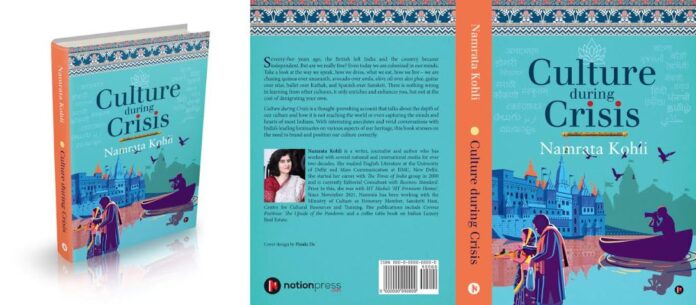A recent book sets the tone of the much-needed Culture Conversation in Indian society. If you do not know where you come from, then you dont know where youre going. And if you dont know where youre going, youre probably going wrong. The book “Culture during Crisis” reminds me of that saying.
Culture during Crisis – A Book by Namrata Kohli
“This beautiful book distils the best learnings from India’s cultural landscape – from the legacy of languages to the beauty of handicrafts, the charm of sari and vintage jewellery to the sound of classical music, the depth of temple architecture, the meaning of daily ritual such as rising early If you are culture compliant, then you are climate compliant and you end up supporting the global ecology also,” says New Delhi author and journalist, Namrata Kohli who recently released a book “Culture during Crisis”.
She feels it is high time we embraced our culture – from buying mitti ke diye, promoting handicrafts, handloom sarees to promoting our native languages. “I think it is high time we went back to our roots. India is now the fifth largest economy in the world and very soon it will be the third largest. A country is not self-sufficient economically only, it must be rich culturally where people are embracing its culture. Cultural capital is the biggest asset of a country like India. Our culture is our brand. It is the gene and lifeblood of this nation. Once we lose that, we lose ourselves and who we are.”
Even as we realize the importance of culture during a (Coronavirus) crisis, the fact is that culture itself is in crisis. COVID-19 came, and look at how our Indian culture helped us during the crisis. Many of the inherently Indian practices of hygiene; Ayurveda; our greeting, namaste; haldi doodh (turmeric latte); kadha (a kind of herbal tea) and Yoga became essential to safeguard oneself from the virus. And the world followed these practices to improve their overall health and wellness quotient – for many, this has been the survival mantra.
Seventy-five years ago, the British left India and India became independent. But are we really free Even today we are colonized in our minds. This is evident in the way we speak, in how we dress, in what we eat and how we live – we chase the avocado over amla, the guitar over sitar, gowns over sarees, prefer to learn a foreign language over our own mother tongue. In short, we are more western than the westerners themselves and have become indifferent to our own culture. There is nothing wrong in learning from other cultures, it only enriches and enhances oneself. But not at the cost of denigrating your own. Today Indians have disinterest in everything Indian and have an obsession with everything western.
Says Kohli, “Do we want our culture to become some kind of a dinosaur, extinct and unwanted, or a relic on some dusty bookshelf, a chapter in our history books, or a white paper in an academic exercise Or, instead, do we want it to be a living, breathing, dynamic entity that organically grows and evolves into something meaningful and becomes a beautiful part of our life When the past meets the present, we can forge the best roadmap for the future.”
The disintegration of Indian culture, she says, is a process that has been slow but steady – much like the frog in boiling water apologue. If a frog is put in boiling water, it will immediately jump out, but if it is put in tepid water, which is then brought to a boil gradually, the frog will not feel the heat and the danger it brings, and will be cooked to death. It is because we are reluctant to react to, or be mindful of, sinister threats that arise gradually rather than suddenly that we become the losers in the long run.
When the British came, they painted a picture of them being superior and we being inferior. Civilizing us was what they called the ‘White man’s burden’. Lord Macaulay brought English education to India with a purpose – to hammer in the inferiority complex. He believed that English education was meant to create “a class of persons, Indian in blood and colour, but English in taste, in opinions, in morals, and in intellect”. The idea was to make the West aspirational, and he succeeded to a great extent. For the Indian today, the idea of advancement and progress is adopting the Western lifestyle. But, can we directly put the blame on Macaulay or is it our failure to invest in our own culture
With interesting anecdotes and vivid conversations with India’s leading luminaries on different aspects of culture, this book is a warm invitation for change for those settling for inadequate lives, mediocre outcomes and discontentment to be more connected with roots. A must read for anyone interested in India.
The book has been written with blatant truth about the current state of affairs in India – how we prefer learning a foreign language versus our mother tongue. In her chapter, Chapter 2: The Legacy of Languages the author quotes Honourable Vice President of India Shri M. Venkaiah Naidu – “We must remember that language only gets nourished by constant use. If you do not use a language, you lose a language.”
But at the same time, there is robust optimism about the future, if we can take the right steps in the present and do course correction now.





























